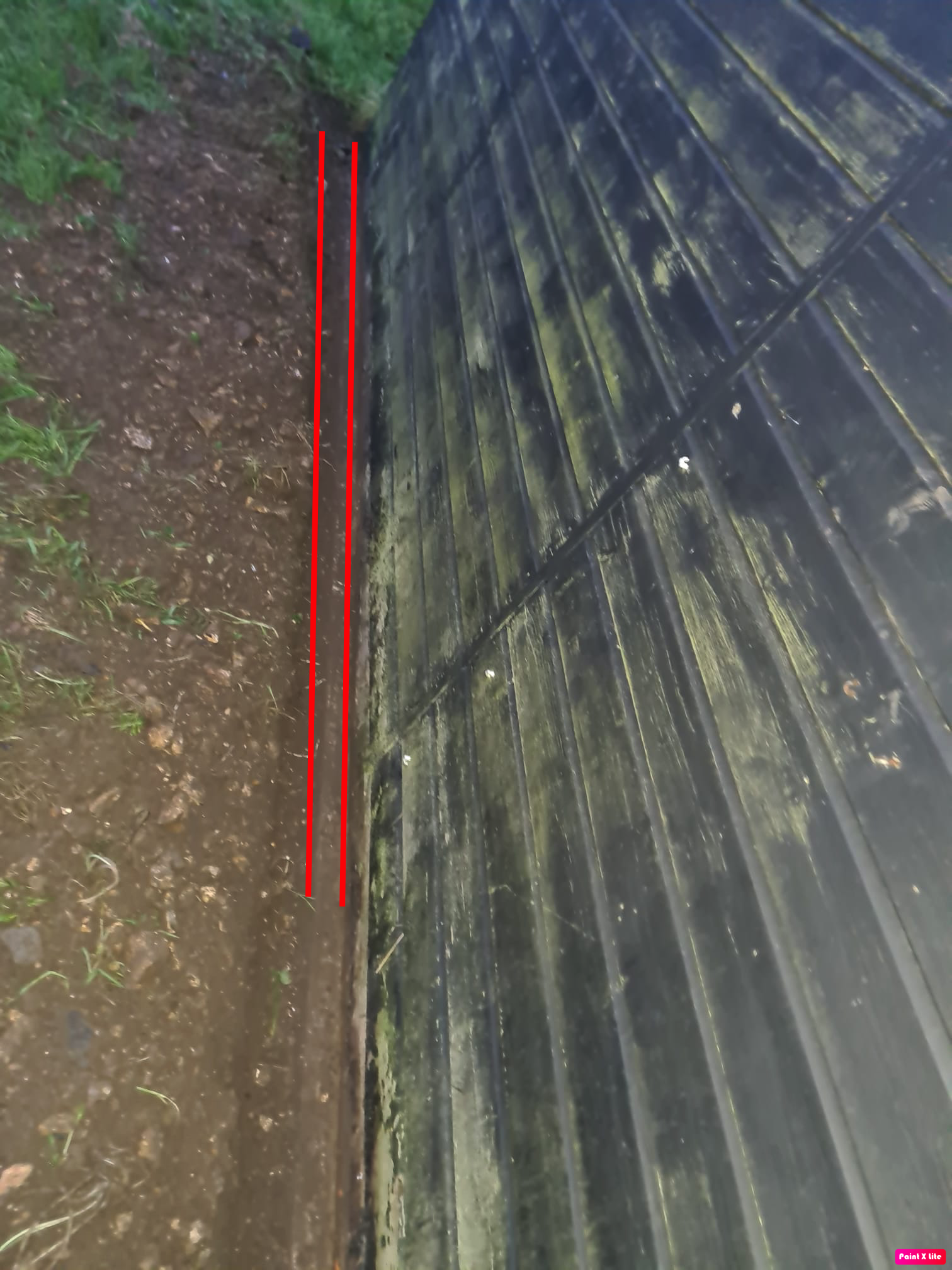We’d like to remind Forumites to please avoid political debate on the Forum.
This is to keep it a safe and useful space for MoneySaving discussions. Threads that are – or become – political in nature may be removed in line with the Forum’s rules. Thank you for your understanding.
📨 Have you signed up to the Forum's new Email Digest yet? Get a selection of trending threads sent straight to your inbox daily, weekly or monthly!
Has MSE helped you to save or reclaim money this year? Share your 2025 MoneySaving success stories!
Timber Garage renovation, focusing on walls now - Need some advice please..
Comments
-
How/what exactly will happen if I fill this area (marked red) in with gravel.Apodemus said:If the soil level at the back is above the bricks, then you need to dig that away and either leave a void exposed to the air or fill with gravel to form a "French drain".
My understanding is gravel will not absorb water. Through Gravel layer water with reach bottom soil level. What I am going to get by filling gravel here..?
Are you suggesting other option is to widen that space and leave empty..? I am sure in goof rain it will become a puddle pool...
I am confused..
0 -
Quite simply, if you dig it out to below slab level, you increase the chances of the water draining away and also allow it all to dry out between rain showers.1
-
sujsuj said:
How/what exactly will happen if I fill this area (marked red) in with gravel.Apodemus said:If the soil level at the back is above the bricks, then you need to dig that away and either leave a void exposed to the air or fill with gravel to form a "French drain".
My understanding is gravel will not absorb water. Through Gravel layer water with reach bottom soil level. What I am going to get by filling gravel here..?
Are you suggesting other option is to widen that space and leave empty..? I am sure in goof rain it will become a puddle pool...
I am confused.. I'm cringing here. It's all very well asking for a bit of help on a forum but you need to have some idea of how buildings are built and why they are done that way rather than setting an intention to bodge it all Heath Robinson style with a pot of bitumen, hope for the best and question people who do this stuff for a living on how something that falls under one of the most basic criteria of the building regulations keeps a building dry.The damp proof course (or floor level) of any structure built should be 150mm above ground level (or gravel level). It prevents water seeping in and also water splashing up and soaking the wall. If you dig deeper than that new ground level, you can put gravel into the trench because it is less dense than earth and will hold more water in the trench and give it plenty of time to drain awayIn your case, you have timber which is even more susceptible to water ingress and rot than masonry is. You need to reduce the ground level so that water can't simply run into the building as it can do now, or splash up and continually soak it.You won't get a puddle, but IF it did form a puddle outside the building, as you're expecting, it would be a puddle outside that started 150mm lower than the timber frame and thus protected it and the interior from the contents of that puddle!Everything that is supposed to be in heaven is already here on earth.
I'm cringing here. It's all very well asking for a bit of help on a forum but you need to have some idea of how buildings are built and why they are done that way rather than setting an intention to bodge it all Heath Robinson style with a pot of bitumen, hope for the best and question people who do this stuff for a living on how something that falls under one of the most basic criteria of the building regulations keeps a building dry.The damp proof course (or floor level) of any structure built should be 150mm above ground level (or gravel level). It prevents water seeping in and also water splashing up and soaking the wall. If you dig deeper than that new ground level, you can put gravel into the trench because it is less dense than earth and will hold more water in the trench and give it plenty of time to drain awayIn your case, you have timber which is even more susceptible to water ingress and rot than masonry is. You need to reduce the ground level so that water can't simply run into the building as it can do now, or splash up and continually soak it.You won't get a puddle, but IF it did form a puddle outside the building, as you're expecting, it would be a puddle outside that started 150mm lower than the timber frame and thus protected it and the interior from the contents of that puddle!Everything that is supposed to be in heaven is already here on earth.
4 -
Thanks very muchDoozergirl said:sujsuj said:
How/what exactly will happen if I fill this area (marked red) in with gravel.Apodemus said:If the soil level at the back is above the bricks, then you need to dig that away and either leave a void exposed to the air or fill with gravel to form a "French drain".
My understanding is gravel will not absorb water. Through Gravel layer water with reach bottom soil level. What I am going to get by filling gravel here..?
Are you suggesting other option is to widen that space and leave empty..? I am sure in goof rain it will become a puddle pool...
I am confused.. I'm cringing here. It's all very well asking for a bit of help on a forum but you need to have some idea of how buildings are built and why they are done that way rather than setting an intention to bodge it all Heath Robinson style with a pot of bitumen, hope for the best and question people who do this stuff for a living on how something that falls under one of the most basic criteria of the building regulations keeps a building dry.The damp proof course (or floor level) of any structure built should be 150mm above ground level (or gravel level). It prevents water seeping in and also water splashing up and soaking the wall. If you dig deeper than that new ground level, you can put gravel into the trench because it is less dense than earth and will hold more water in the trench and give it plenty of time to drain awayIn your case, you have timber which is even more susceptible to water ingress and rot than masonry is. You need to reduce the ground level so that water can't simply run into the building as it can do now, or splash up and continually soak it.You won't get a puddle, but IF it did form a puddle outside the building, as you're expecting, it would be a puddle outside that started 150mm lower than the timber frame and thus protected it and the interior from the contents of that puddle!0
I'm cringing here. It's all very well asking for a bit of help on a forum but you need to have some idea of how buildings are built and why they are done that way rather than setting an intention to bodge it all Heath Robinson style with a pot of bitumen, hope for the best and question people who do this stuff for a living on how something that falls under one of the most basic criteria of the building regulations keeps a building dry.The damp proof course (or floor level) of any structure built should be 150mm above ground level (or gravel level). It prevents water seeping in and also water splashing up and soaking the wall. If you dig deeper than that new ground level, you can put gravel into the trench because it is less dense than earth and will hold more water in the trench and give it plenty of time to drain awayIn your case, you have timber which is even more susceptible to water ingress and rot than masonry is. You need to reduce the ground level so that water can't simply run into the building as it can do now, or splash up and continually soak it.You won't get a puddle, but IF it did form a puddle outside the building, as you're expecting, it would be a puddle outside that started 150mm lower than the timber frame and thus protected it and the interior from the contents of that puddle!0 -
Thanks for the inputs.
After digging & putting gravel, any of other measures listed will have any impact? Thanks
(1) remove current brick layer and lay them again..? even getting new bricks from shop?
(2) have a a second brick row outside current one with some dpc layer between 2 brick rows..?
(3) plastering over outer brick layer
(4) Finally bitumen paint over over the outer brick row
0 -
If they need repointing, repoint them, otherwise no. Leave them.Everything that is supposed to be in heaven is already here on earth.
1 -
Does the building have drainage? What's the rainwater situation?Everything that is supposed to be in heaven is already here on earth.
1 -
Dead horse and flog spring to mindA thankyou is payment enough .2
-
sujsuj said:Thanks for the inputs.
After digging & putting gravel, any of other measures listed will have any impact? Thanks
(1) remove current brick layer and lay them again..? even getting new bricks from shop?
(2) have a a second brick row outside current one with some dpc layer between 2 brick rows..?
(3) plastering over outer brick layer
(4) Finally bitumen paint over over the outer brick rowIt is really the wrong time of year to be attempting this kind of work. Treating damp problems in the spring/summer is a much better idea as it gives the materials an opportunity to dry out. You also avoid potential problems with frost affecting concrete and mortar. The damage is largely done already, it won't get significantly worse over the next 4 to 6 months or so.Then get a professional to sort the walls out for you. DIYing is great for moneysaving, but attempting the DIY approach on unsuitable projects typically ends up costing more. The complications in your garage situation need professional involvement.1
Confirm your email address to Create Threads and Reply

Categories
- All Categories
- 352.9K Banking & Borrowing
- 253.9K Reduce Debt & Boost Income
- 454.7K Spending & Discounts
- 246K Work, Benefits & Business
- 602.1K Mortgages, Homes & Bills
- 177.8K Life & Family
- 260K Travel & Transport
- 1.5M Hobbies & Leisure
- 16K Discuss & Feedback
- 37.7K Read-Only Boards




